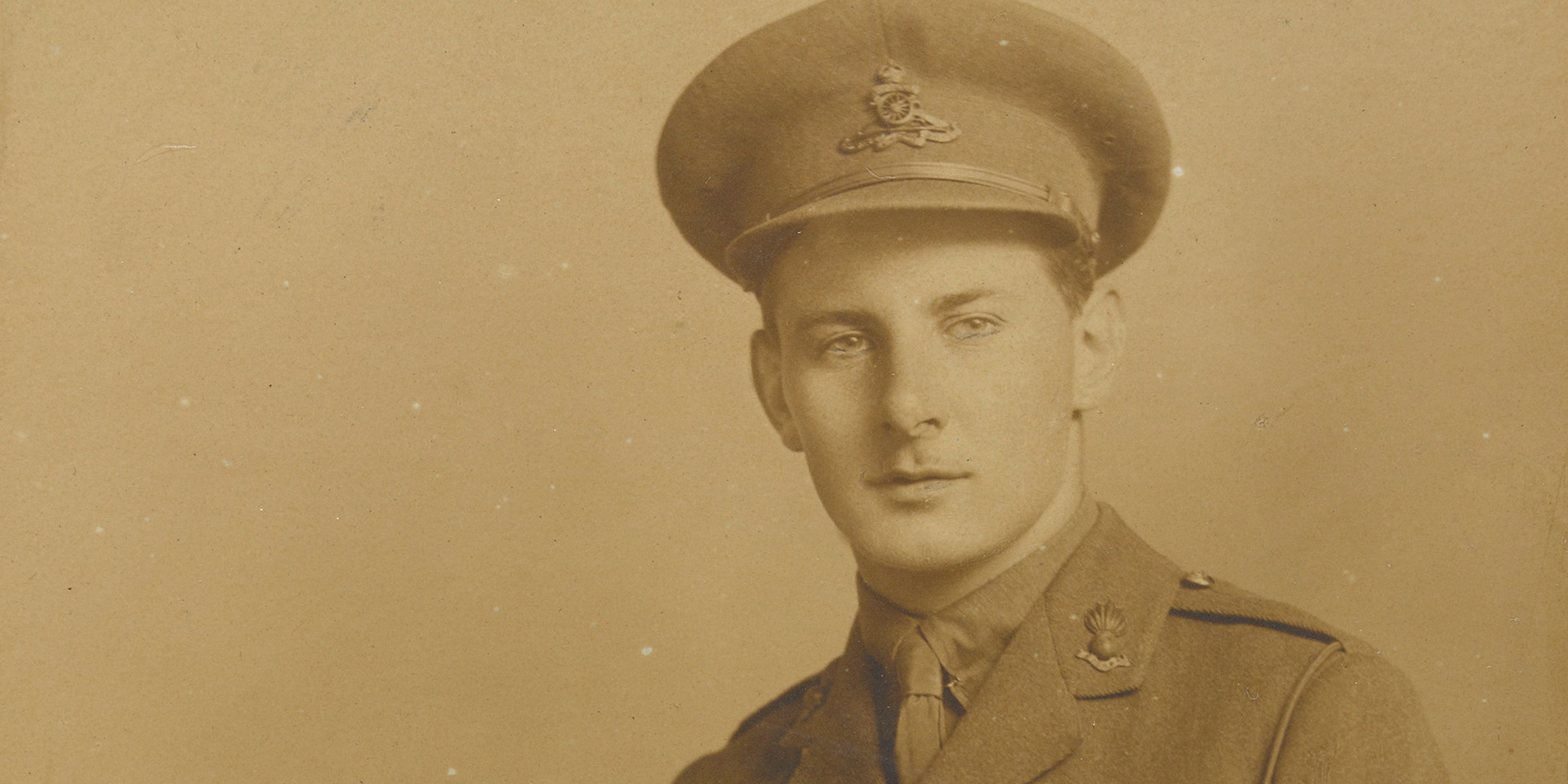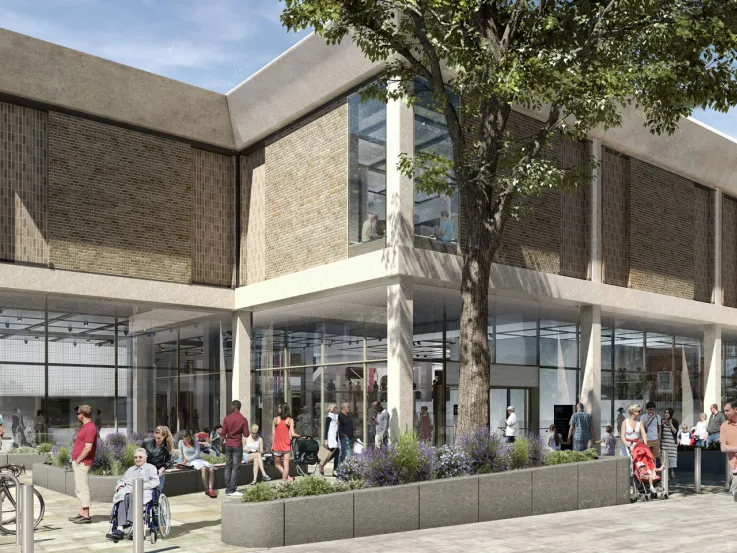Family letters tell tragedy of young soldier's death on Armistice Day
A collection of letters and photographs from the archive at the National Army Museum depicts the conflicting emotions of Armistice. They describe the tragic death of 19-year-old Second Lieutenant Noel Evans on the morning peace was signed, and the impact it had on those close to him.
For thousands of families who had suffered the loss of loved ones during the war, the signing of the Armistice on 11 November 1918 was a bittersweet occasion. Feelings of jubilation and relief that the fighting had ended were tempered by heartache and anguish at the terrible price that had been paid for peace.
Noel Evans had arrived at the front in mid-September 1918. He was serving with 121st Battery in the 27th Brigade, Royal Field Artillery, the unit in which his brother also served. By the time Noel arrived, this formation had been in almost continuous action since the German Spring Offensive of March 1918, and was now taking part in the Allied advance that took place after their victory at the Battle of Amiens in August.
During his brief time in service, Noel and his comrades were frequently exposed to grave dangers and he survived several near misses. On 24 October 1918 he wrote home:
'We are at the moment halting, waiting for more orders. We often see the civilians of the towns, they look very ill, most of them. I have been having quite a thrilling time lately being chased by shells, but so far have been very lucky. I have got a piece of shrapnel that missed my cheek by a fraction of an inch and hit a wall beside me, so pocketed it and moved on.'
Noel’s luck finally ran out during the Battle of the Sambre. On 4 November 1918, a week before the hostilities ended, a shell burst a few yards from the dug-out where he was on duty. His commanding officer, Major L Bonner, 121st Battery, later wrote to his parents describing the events:
'At about 6.30am, Noel went on duty and remained at the guns till 7.30am. Soon after this, at about 7.45am I should think, I was standing outside the dug-out and Noel walked towards me and we stood chatting for a few minutes; then I re-turned to the dug-out and had just stooped under the tarpaulin when a shell burst a few yards away. Our cook, who stood at the entrance of the dug-out, fell over on top of me, shot through the neck, and I was busy bandaging him when Noel was brought in. He appeared to be slightly wounded in the left thigh and right heel, and a tiny splinter was pulled out of the back of his head; his thigh seemed to worry him most, but the hit on the head had caused him to go temporarily blind: we put this down to concussion.'
Noel was evacuated to a hospital in the rear, while the Allied advance continued. Under relentless pressure, the Germans were eventually forced to sue for peace. At 5am on 11 November 1918, in a railroad carriage at Compiègne in France, the Allies signed an armistice with Germany. At 11am that day, the ceasefire came into effect, finally ending the war.
Noel’s parents travelled to France to visit him in hospital. However, on arrival they were informed that their son had succumbed to his wounds in the early hours of Armistice Day. Although the recipient of this letter from his father is unknown, it helps capture the tragedy with clarity and beauty:
'It has been the hardest week to bear of my life... the uncertainty of the dear laddies’ condition. The suspense at the last moment when we reached the hospital and the crushing words of the matron 'I’m afraid I have bad news for you'. We were too late. He had passed away on Monday morning in the early hours, strange to say just about the time the armistice was signed!... We reached the cemetery just in time. There were 2 other officers and about 20 privates buried at the same time. Noel was carried by five soldiers and five officers marched at the side… 3 volleys were fired and the 'Last Post' sounded at the end. And there we have left our dear high-spirited laddie, who loved everybody and I believe was loved by all… It is such hard lines that he should have been taken at the very end of the war.'
Peace came at a huge price. 1918 was the most devastating year on the Western Front. The mobile warfare since March had cost each side over a million men.
Noel was buried in a cemetery near Rouen along with 30 of his comrades. Against the backdrop of the victory celebrations, his heart-broken family headed back to Britain to mourn, with his mother Violet Evans writing to her sister on 16 November:
'To think that we shall never see his dear smile again. It’s all been so cruelly hard... all the horrible noise and crowds and rejoicing everywhere day and night, it has been a continuous nightmare and the journey back I thought never would come to an end. It was such an awful shock when we got there to be told he had already gone to the cemetery… I don’t know how to face life without him.'
Notes to editors
For more information, please contact Claire Blackshaw at cblackshaw@nam.ac.uk or 020 7881 2433.
- Visit First World War in Focus at http://ww1.nam.ac.uk
- Entrance to the Museum is free, with varying prices for special exhibitions
- Opening hours are: daily, 10am – 5.30pm, until 8pm first Wednesday each month and closed on 25, 26 December and 1 January
Join in the conversation:
- Twitter: @NAM_London
- Facebook: facebook.com/NationalArmyMuseum
- Instagram: @NAM_London
About Noel Evans
Noel Everard Evans (1898-1918) was born on 26 December 1898 at Chirk in Denbighshire, the son of the Reverend Enoch James Evans and his wife Violet Evans. Noel's father was a vicar at St Trillo's Church at Llandrillo-yn-Rhos (Rhos on Sea) in Colwyn Bay. His grandfather, Major Thomas Everard-Hutton of the 4th Queen's Own Light Dragoons, had been wounded in the infamous Charge of the Light Brigade during the Crimean War (1854-56).
Noel was educated at Colet House School in Rhyl and Llandovery College. He excelled at sport, exhibiting such ability that, had it not been for the war, a professional career may well have been open to him. However, this was not to be. Like most young men of his generation, Noel was called upon to serve.
In June 1918, he was commissioned into the Royal Field Artillery (RFA). After a short period of further training, he arrived in France during September. Noel served alongside his older brother Morgan in the 27th Brigade, RFA, until his death on 11 November 1918.
Noel was laid to rest in the St Sever Cemetery Extension at Rouen. A stained glass window was also erected in his memory at St George's Church, Llandrillo-yn-Rhos.
National Army Museum
The National Army Museum is the leading authority on the history of Our Army. Founded in 1960 by Royal Charter and established for the purpose of collecting, preserving and exhibiting objects and records relating to the Land Forces of the British Crown, it is a museum that moves, inspires, challenges, educates and entertains.
The Museum seeks to tell the story of Our Army, the personal experiences of the soldiers who have served in it and to connect the British public and its army, demonstrating how the role of Our Army and its actions are still relevant today.
Heritage Lottery Fund
Thanks to National Lottery players, we invest money to help people across the UK explore, enjoy and protect the heritage they care about - from the archaeology under our feet to the historic parks and buildings we love, from precious memories and collections to rare wildlife.
For more information, please contact Katie Owen, HLF press office on 020 7591 6036 or 07973 613820 (out of hours mobile).


